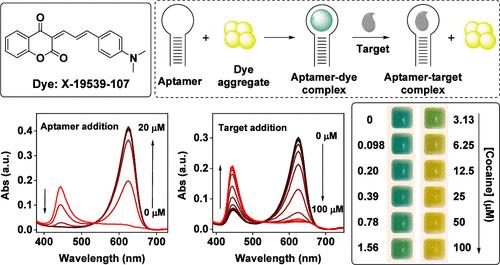High-Contrast Aptamer-Based Merocyanine Displacement Assays for Sensitive Small Molecule Detection
IF 9.1
1区 化学
Q1 CHEMISTRY, ANALYTICAL
引用次数: 0
Abstract
Aptamer-based colorimetric dye-displacement assays offer a promising means for on-site detection due to their single-step mix-and-read procedure and rapid naked-eye readout. Here, analyte binding to noncovalent aptamer-dye complexes triggers the displacement of the dye into solution, resulting in the formation of aggregates with divergent optical absorbance properties from the monomeric aptamer-bound dye. However, these assays suffer from low sensitivity, poor color contrast, and small absorbance wavelength shifts between the dye monomers and aggregates, as well as the large spectral overlaps between these two forms. Here, we introduce the solvatochromic coumarin-based merocyanine dye X-19539-107 as a novel indicator that enables the highly sensitive detection of small-molecule targets in dye-displacement assays. In aqueous solution, the dye forms H-aggregates that absorb at 445 nm, whereas aptamer-bound dye monomers absorb at 610–625 nm─a difference of up to 180 nm, with minimal spectral overlap. We utilize X-19539-107 in dye-displacement assays with diverse aptamers to detect various small-molecule analytes with unprecedentedly high target-induced dye displacement efficiency and greater sensitivity than conventional cyanine indicators and excellent color contrast. We also demonstrate cocaine detection at toxicologically relevant levels in saliva, highlighting the real-world utility of these assays. We conclude that our merocyanine dye offers a powerful alternative to cyanine dyes for colorimetric aptamer-based sensing.

基于高对比度适配体的Merocyanine置换法用于敏感小分子检测
基于适体体的比色染料置换法由于其单步混合读取程序和快速裸眼读出,为现场检测提供了一种有前途的方法。在这里,分析物与非共价适配体-染料配合物的结合触发染料位移到溶液中,导致与单体适配体结合的染料形成具有不同光学吸收特性的聚集体。然而,这些检测方法存在灵敏度低、颜色对比度差、染料单体和聚集体之间的吸收波长变化小以及这两种形式之间的大光谱重叠等问题。在这里,我们介绍了基于香豆素的溶剂化变色merocyanine染料X-19539-107作为一种新的指示剂,可以在染料置换分析中高度敏感地检测小分子目标。在水溶液中,染料形成h聚集体,吸收波长为445 nm,而与适体结合的染料单体吸收波长为610-625 nm,差异可达180 nm,光谱重叠最小。我们利用X-19539-107在不同适配体的染料置换试验中检测各种小分子分析物,具有前所未有的高靶诱导染料置换效率,比传统的花青素指示剂更高的灵敏度和出色的颜色对比度。我们还展示了唾液中毒理学相关水平的可卡因检测,突出了这些检测的实际效用。我们得出的结论是,我们的merocyanine染料提供了一个强大的替代花青素染料的比色适体为基础的传感。
本文章由计算机程序翻译,如有差异,请以英文原文为准。
求助全文
约1分钟内获得全文
求助全文
来源期刊

ACS Sensors
Chemical Engineering-Bioengineering
CiteScore
14.50
自引率
3.40%
发文量
372
期刊介绍:
ACS Sensors is a peer-reviewed research journal that focuses on the dissemination of new and original knowledge in the field of sensor science, particularly those that selectively sense chemical or biological species or processes. The journal covers a broad range of topics, including but not limited to biosensors, chemical sensors, gas sensors, intracellular sensors, single molecule sensors, cell chips, and microfluidic devices. It aims to publish articles that address conceptual advances in sensing technology applicable to various types of analytes or application papers that report on the use of existing sensing concepts in new ways or for new analytes.
 求助内容:
求助内容: 应助结果提醒方式:
应助结果提醒方式:


